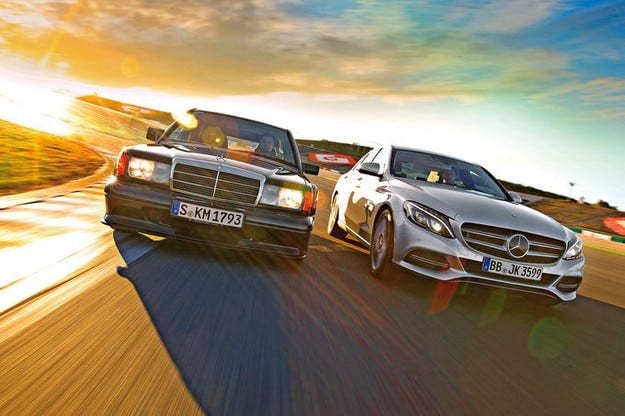
Test drive Mercedes C 350e and 190 E 2.5-16 Evo II: Oratorio for four cylinders

Mercedes C 350e and 190 E 2.5-16 Evolution II meet on the track
We often speak and write as if the world of sports cars at that time consisted only of models with six cylinders and more. In general, then everything was better than it can be today. You see, then gasoline cost nothing, and the cars lasted forever, well, or at least until the next engine change. That is why we persistently, often with good reason, shed tears over the miniaturization of motorcycles in the process of downsizing. To whom did he give his heart to decompose a BMW M3 from eight to six cylinders? Why is the new Mercedes C 63 AMG missing 2,2 liters of displacement? And why is there no champagne in my office? At the same time, we forget that many of the heroes of four-wheeling started their careers with a four-cylinder engine.
Do you remember how magical the abbreviation 16V sounded in the 80s and 90s? Four valves per cylinder, that symbol of an affordable sports bike in impressive machines like the Opel Kadett GSI 16V with a Cosworth cylinder head. Or Mercedes 2.3-16, also modified by English racers. At the same time, the 2.3 was still not the best - it appeared in 1990 with a 2.5-16 Evo II and a rear wing the width of a beer bench. So, a 2,5 liter short-stroke engine that struggles for 235 horsepower at many revs. What a figure for those times! And what great duels with the BMW M3 - in those years when the DTM was not yet composed of aerodynamic monsters arranged like beads on a perfect line. At the time, the Evo II, limited to 500 units, was the most powerful four-cylinder version of the 190 range.
Proud decoration of the cross
The model demonstrates this power with her huge wing - something like tattoos that some people do on the waist. “In the era of bodybuilding, the Mercedes model is quite openly presented to the world as a sports car with plastic attributes,” Auto Motor und Sport wrote in 1989 on the occasion of the Evo I. Bodybuilding today is modern. top hairstyles. That's why the most powerful four-cylinder version of the C-Class to date seems as meek as a church choir singer. The restraint of the purest example for a power unit, impressive not only in comparison with the then: 279 hp. and 600 Nm. Values that a Ferrari 1990 tb could boast of in 348 - only with a rather frivolous 317 Nm. However, while both the Ferrari and Evo II pour gas like Chianti at a rural wedding in Tuscany, the hybrid model from Stuttgart is content with a miserly 2,1 liters per 100km. According to – pause – European standard.
Calm before the storm
The standard is a statistically possible cost after a painstaking two-hour charge from a wall outlet. Otherwise, in practice, you should be prepared for values from zero to ten liters per 100 km - depending on the type and length of the route.
And now two four-cylinder star cruisers stand as a monument to their automotive era at the Portimão Racecourse near Faro, Portugal. On the one hand, an extroverted, gas-hungry, fast-moving monster, on the other, a mighty eco-hybrid sport that can do anything but knit. Common to both machines is an almost meditative lull before the start. In the 350e, this is a logical consequence of the letter e, which means electric drive. A 60 kW (82 hp) synchronous disc-shaped electric motor between the combustion engine and transmission provides up to 31 kilometers of pure electric range, powered by a lithium-ion battery with a net energy density of 6,4 kWh. The distance is easily achievable with a slight headwind and tilt. In the all-electric mode of the dual-clutch hybrid system, the C-Class pulls surprisingly softly, quietly and with a force of 340 Nm. A wonderful soothing agent for noisy urban centers. This is probably the most pleasant side effect of electromobility.
However, peace reigns with the old saw. At low revs and a sudden lack of traction, the Evo glides along the road with a quiet murmur like any other four-cylinder car. “Impeccably quiet running” is the former assessment of auto motor und sport. At the time, that sounded flattering for a sports engine. For today's generation, accustomed to the torque of turbo engines, meeting this cheeky Mercedes is sobering, like a non-alcoholic bachelor party. Already at 4500 rpm they begin to serve a drink - then the Evo sings the old DTM anthem through its silencer with fervor. A provocative aria filled with roar, whistle and rattle. During the concert, the pilot almost stumbles through a typical H-shift, in which the reverse gear is left and forward. Finally, the asphalt is on fire - of course, by the standards of the time. If you believe your feelings, you are Bernd Schneider, who came to conquer Portimão. At least until this humble silver thing starts peeking out its rear fender with its LED headlights.
The plug-in hybrid driver then quietly pedals past the automatic transmission threshold to open the throttle to full throttle and puts the 2,1-liter four-cylinder turbo engine into play. Now the crankshaft is loaded with another 211 hp. and 350 Nm. For everyone who, taking into account the total power of 279 hp. suspects an error in the calculations, we recall that the electric motor is strongest at low speeds, and the engine at high speeds. Thus, both devices do not reach their maximum at the same speed.
Dynamically, they are separated by light years.
Even a 100-5,9 mph time of 7,1 and 190 seconds sends the C-Class and XNUMX to different worlds, and the difference in thrust sends them to different galaxies. Without hesitation and with refined manners, the plug-in hybrid quickly overtakes the Evo, later stopping at a tight corner to accelerate again with a restrained exit growl. You want to take your hat off to this impressive feat of engineering from Stuttgart. Before this successful split between the economy and sportsmanship. Before that, the mode is changed from direct to soft accelerator pedal reactions and before the inclusion of terrain topography in the working strategy of the hybrid. Before this comfort... The only thing that surprises you is the pulse.
It is calmer and slower than the old starship. With the same gas flow, it completely captivated you and at the same time defied you as the wide rear fender with smoking tires rushed towards the surrounding Portuguese vegetation. Sometimes you love Evo, sometimes you hate him, but he never leaves you emotionless. He may not be a twine master, but he maintains a lot of tension.
Mr. Haytech has no fenders or wide drifts because it is impossible to turn off the ESP completely. No side walks are expected from him. Smart guy, perfect son-in-law ... And can't we take them home?
CONCLUSION
When former driver Barnd Schneider talks about the old days in the DTM with the 190, he falls into dreams. In nostalgia for the era of strong emotions, when everything was even more unpredictable than today. Thus, it accurately conveys the essence of the two four-cylinder models. Evo is made for the heart. His behavior at the limit of thrust can harden the characters, and his desire for gasoline is insatiable. This is infinitely far from the idea of being the perfect car, but someone who owns one of 500 copies does not want to part with it. Unlike the veteran, the C350e proves what is possible today if designers focus on a mid-range model armed with all the power of engineering and computer knowledge. It's an impressive compromise between the desire for more power and today's emission limits. At that time, the Evo cost about 110 marks, today the plug-in hybrid sells for 000 50 euros - in both cases, a lot of money.
Text: Alexander Bloch
Photo: Hans-Dieter Zeifert
Home " Articles " Blanks » Mercedes C 350e and 190 E 2.5-16 Evo II: Oratorio for four cylinders

